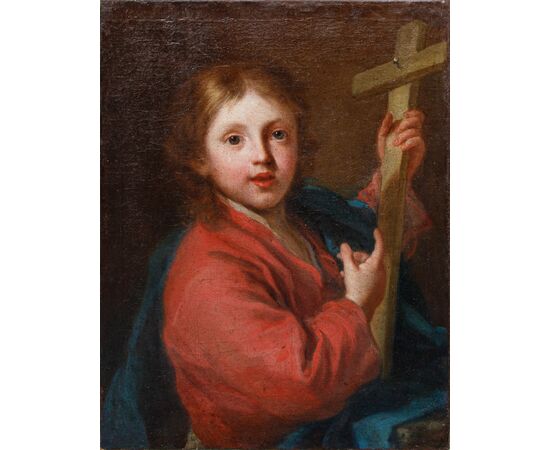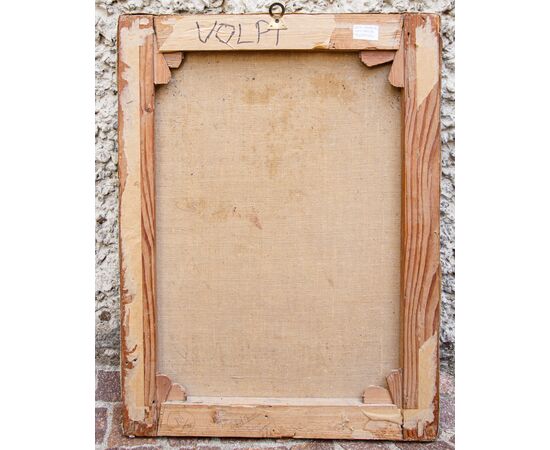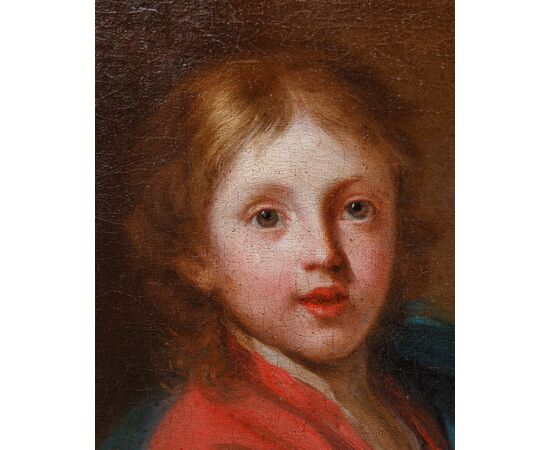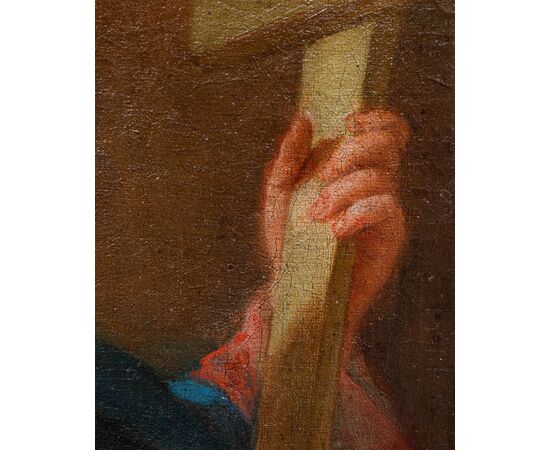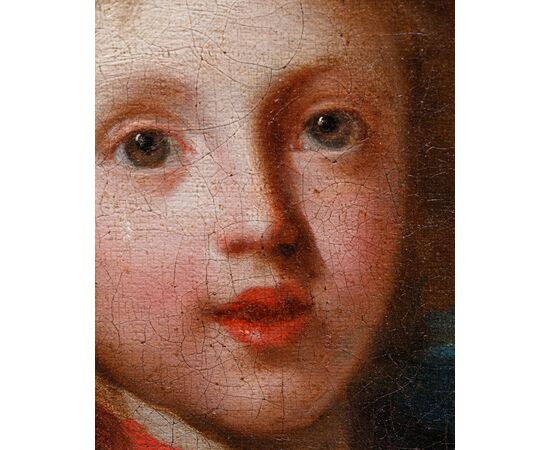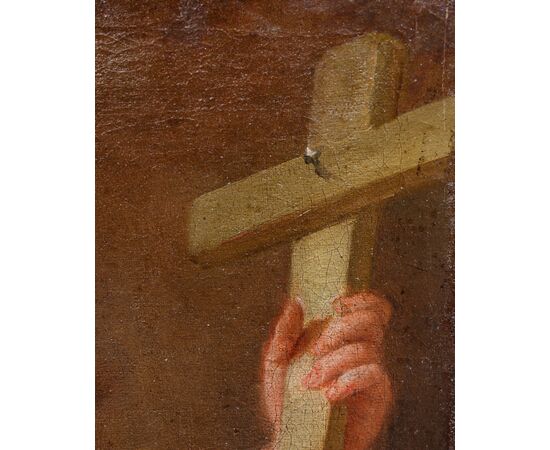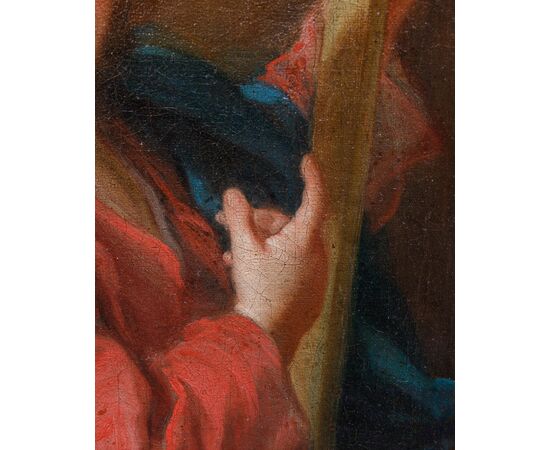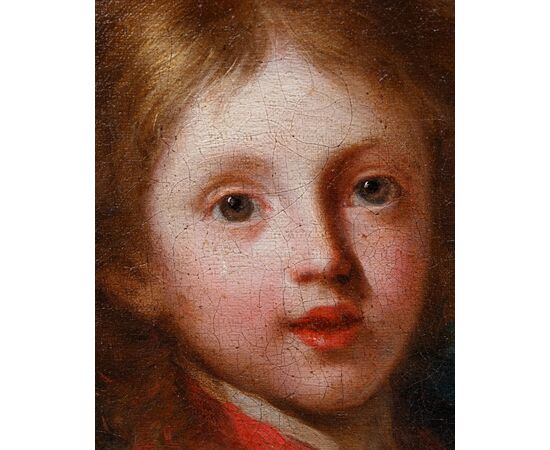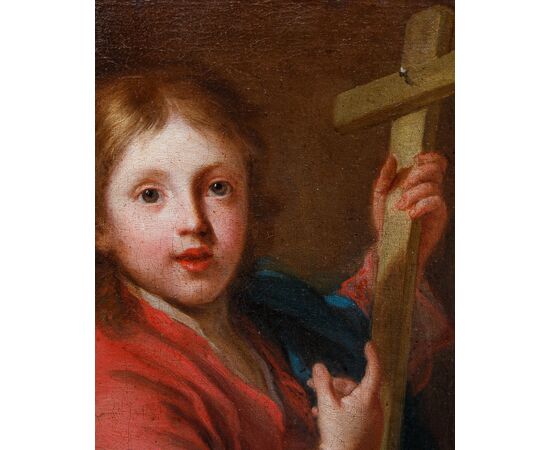Nicolas de Largillière (Paris, 1656 – 1746), Infant Jesus pointing to the cross
Nicolas de Largillière (Paris, 1656 – 1746)
Infant Jesus pointing to the cross
Oil on canvas, 60 x 42 cm
Critical note by Prof. Emilio Negro
The painting in question proposes an unusual and, at the same time, fascinating iconographic scheme, that of the Christ child pointing to the cross, the instrument of his martyrdom and prefiguration of his death and resurrection for the redemption of human sins. Infant Jesus turns almost playfully towards those looking on: what immediately strikes the eye is the lively gaze of the infant, who interacts directly with the viewer. The depiction of Christ is of a naturalistic and encyclopedic nature and clearly shows various references to the Northern European tradition of the so-called Golden Age, the 17th century. Due to this characteristic and the choice of a range of light and bright colors, the work can be attributed to the corpus of Nicolas de Largillière, an artist of French origins trained in Antwerp between the 17th and 18th centuries who was well aware of the stylistic features of Nordic painting. Nicolas de Largillière, a French painter of Flemish origin, is a key figure in the artistic panorama of the 17th and 18th centuries, famous for his lavish portraits and his ability to capture the elegance and grandeur of the aristocracy and bourgeoisie of his time. His long and prolific career saw him witness and interpret the stylistic changes that led from the Baroque to the Rococo, leaving a legacy of works that still fascinate today for their vivacity and refinement. Born in Paris into a family of merchants, Largillière spent his childhood in Antwerp, in the Spanish Netherlands, where his father initially steered him towards a commercial career. However, his innate propensity for art naturally pushed him towards painting. He trained with Antoine Goubeau, a painter specializing in still lifes and landscapes, who conveyed to him the technical solidity and attention to detail typical of the Flemish school. It was a fundamental apprenticeship that provided him with the basis for developing his distinctive style. Around 1674, Largillière moved to London, where he worked for several years in the studio of Peter Lely, the leading portrait painter at the court of Charles II. This experience was crucial to his artistic maturation. In contact with Lely, a master of court portraiture, Largillière refined his ability to represent figures of high rank, learning to infuse his subjects with regal grace and dignity. His stay in England also allowed him to appreciate the richness of color and the vivacity of brushstrokes typical of the English tradition. Returning to Paris in 1679, Largillière quickly established himself as one of the most sought-after portrait painters in the capital. His ascent was rapid: in 1686 he was admitted to the Académie Royale de Peinture et de Sculpture and in 1705 he became a professor, before reaching the position of rector in 1722 and finally director in 1738. These academic recognitions testify not only to his undisputed mastery, but also to his influential role in the formation of new generations of artists. Largillière's clientele was vast and heterogeneous, including members of the royal family, such as Louis XIV and his successors, the court aristocracy, wealthy bourgeois, magistrates, scholars and artists. He excelled in representative portraiture, where his subjects were often depicted in sumptuous clothes, surrounded by symbols of status and elaborate backdrops. His rich and pasty brushstroke, the brilliant use of color and the ability to render the textures of fabrics and jewels, gave his portraits extraordinary opulence and vitality. An emblematic example of his style is the Portrait of the Largillière Family (c. 1704), a work which, despite being a family self-portrait, reveals the same grandeur and attention to detail as his official portraits. The Portrait of Louis XIV (c. 1700) also shows his ability to capture the majesty of the Sun King, infusing the monarch with an aura of power and authority. In addition to official portraits, Largillière also created numerous more intimate and personal portraits, where his sensitivity was manifested in the ability to grasp the psychology of his models. Although portraits are the focus of his production, he occasionally ventured into still lifes, landscapes and historical works, demonstrating remarkable versatility. Largillière was a meticulous artist, who dedicated great attention to detail and composition. His workshop was renowned for its organization and efficiency, and many young artists trained under his guidance. His influence was lasting and extended to several French painters of the 18th century, who took up and developed his innovations in portraiture. Nicolas de Largillière died in Paris in 1746, at the age of ninety, leaving an imposing artistic legacy and a catalog of over a thousand works. His career, so long and full of successes, consecrates him as one of the greatest portrait painters of his era, a master who knew how to immortalize with elegance and splendor the golden age of France, providing us with a precious gallery of faces that still speaks to us today of an era of great refinement and magnificence.
The marked portrait connotation of our painting means that it can be perfectly incorporated into De Largillière's corpus: in fact, other similarities can be found with the Portrait of the Countess of Rupelmonde, the Sketch for a Child's Head and the Double Portrait of Prince James Francis Edward Stuart and Princess Louisa Maria Teresa Stuart, currently part of the collections of the National Portrait Gallery in London. In particular, the delicate features of the London prince closely resemble the features of our Infant Jesus pointing to the cross. With our painting, the aforementioned works share the graceful compositional taste of an Italianizing nature typical of French painting between the 17th and 18th centuries and the choice of warm, light and bright colors.

